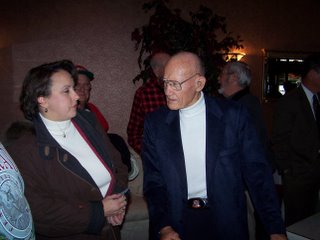Grove Veteran Recalls Kamakazi Attack

Memo to President George Bush:
Here in Grove, Ok. is a US Navy WWII survivor of the first Kamakazi attack on a Navy carrier, severely injured when his ship was blown to pieces, but to this day has never been paid for nearly 9 months of duty after the incident. The US Navy said he was dead and "they don't pay dead people." Stogner was part of the historic Battle of Leyte Gulf, where 3,000 sailors died.
With interest, his paychecks come to around $30,000.
John Stogner told his survival story to members of the Grove Rotary Club this week on the anniversary of Pearl Harbor, and you could have heard a pin drop as the silent audience listened.
It was Oct. 25, 1944, he recalled, and the St. Lo, a small aircraft carrier, part of the Taffy III Group, was on duty in the South Pacific near the Phillipine Islands, providing air cover. The alarm sounded for General Quarters just about sunrise and a huge Japanese fleet was seen coming over the horizon, eight battleships, 10 cruisers and 15 destroyers in all. The battleships could fire 18 inch shells while the St. Lo had only five inchers. (The St. Lo was formerly the USS Midway and had been recently renamed in honor of the men who died in St. Lo, France during the D Day Landing.)
"We zigged and zagged to avoid their shells and never got a direct hit. Our planes won the air battle but we lost four planes due to a landing accident and just as it appeared the Japanese were winning, they turned and left the area.
"But then came the suicide squadron, 24 in all…carrying two 550-pound bombs on each plane.
I got hit by a bomb blast that blew a huge hole in the side of the ship. Other explosions followed. I was knocked unconscious, covered in debris. I later woke up, telling my shipmates to go on and leave me there. I knew I was not going to make it.
"Suddenly my wife's face appeared in front of me saying 'you can make it.' I crawled out of the hole with twisted wreckage all around and got to the fantail. Then the ship rolled over and I slipped into the sea, covered in oil in 10 foot waves. It looked like it was raining toothpicks (timbers blown into the air and retreating to the ocean)."
The ship's sinking took only 30 minutes from the time the suicide bombers flew into it.
"There was not a sound, nothing in sight, so I swam for about an hour and came upon half of a raft with four other badly injured sailors. Then four Japanese planes came over us, low and fast and I figured we were going to get strafed so I slipped into the water and got away from the raft. There were sharks all around us and many died from shark attacks.
"At some point, the destroyer USS Raymond saw us but to make matters worse, an unexploded torpedo that had run out of fuel was too close so the ship could not move in for the rescue.
"After awhile the torpedo had moved to a safe distance away and the Raymond picked up everyone. (The Raymond eventually was taken to the Philadelphia Naval Yard)
"I passed out as they carried me aboard, my leg was badly blown up. I spent four days on another ship and then the hospital ship "Comfort." It took us to New Guinea and in the meantime my wife had been notified that I was killed in action. I wrote her and told her I was still alive and I was eventually taken to Brisbane, Australia. Another ship took us back to the States and the Great Lakes Naval Hospital near Chicago where I spent another 8 months recuperating and was united with my wife again," Stogner told the Rotarians.
He was awarded the Bronze Star and Purple Heart.
About that paycheck, Mr. Bush:
"From Oct. 25, 1944 until the time I was discharged nine months later, I never got paid since I had been reported killed," said Stogner. "In a few months the war ended," he added.
Efforts by Congressman Dan Boren and his predecessor, Brad Carson, to obtain the paychecks for Stogner were unsuccessful; the US Government said the records for WWII were "closed."
But Stogner's memory of the event is easily recalled, a time long ago but not forgotten.
(In photo above, at right John Stogner talks with Kay Lynn Beauchamp, Rotary member.




0 Comments:
Post a Comment
<< Home